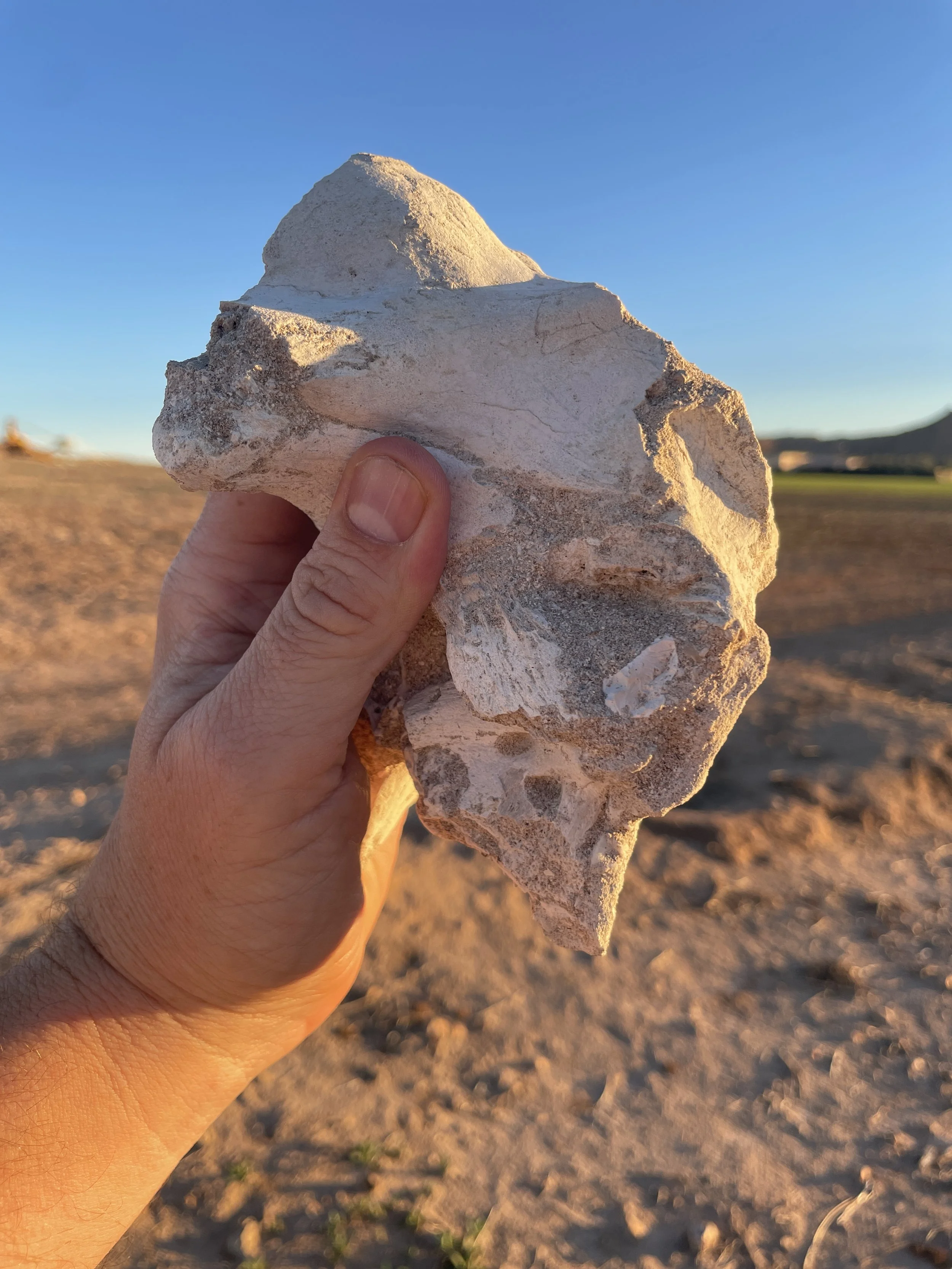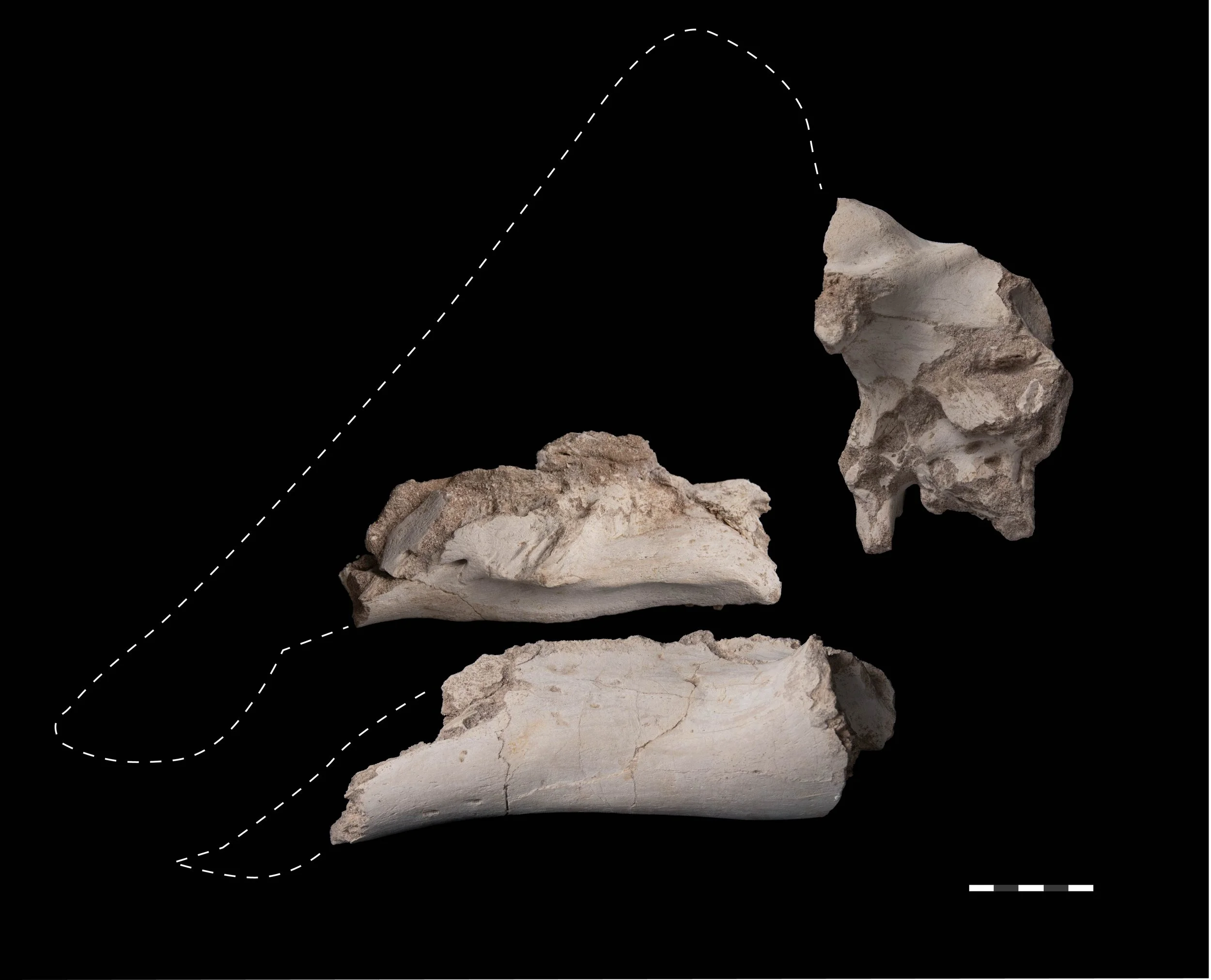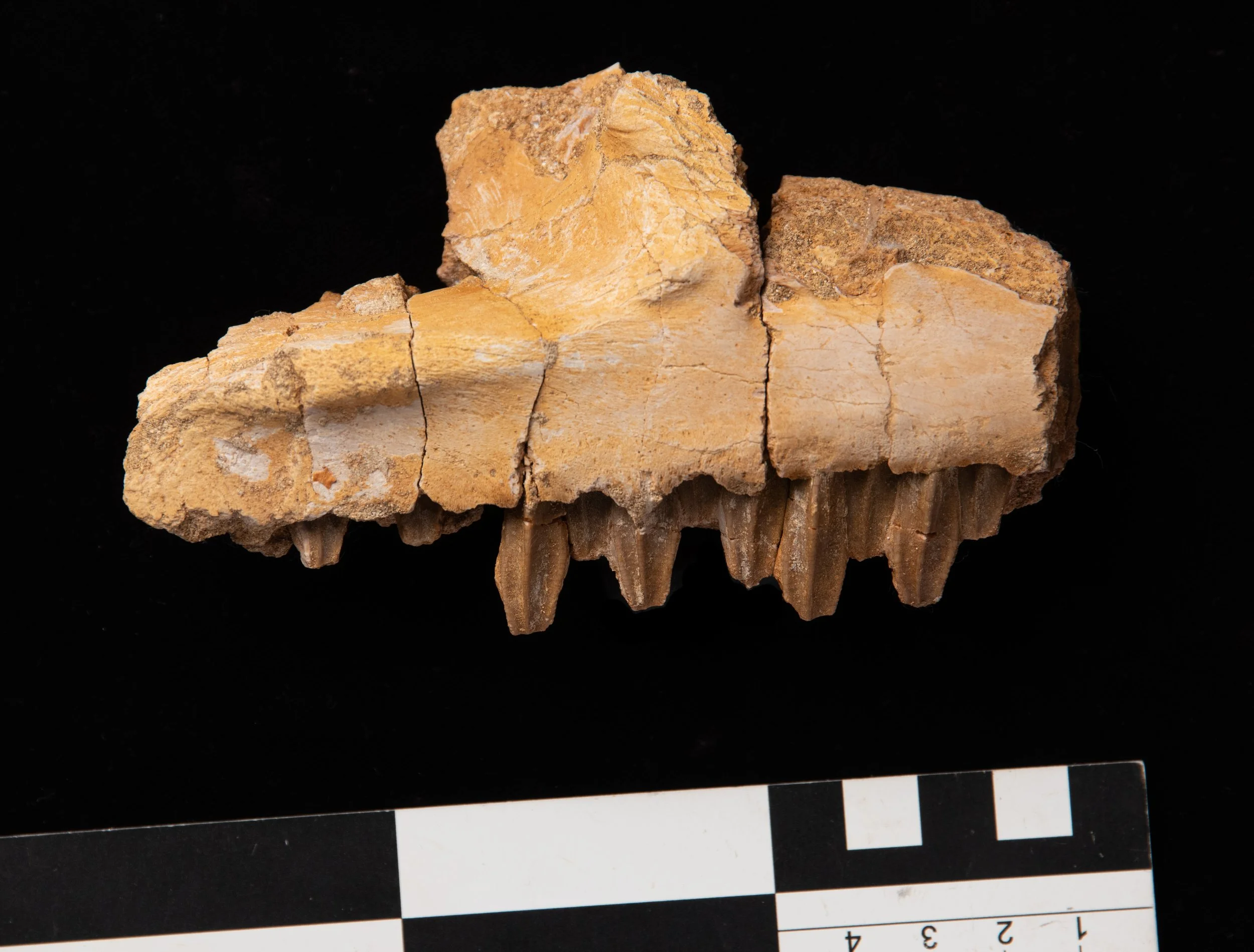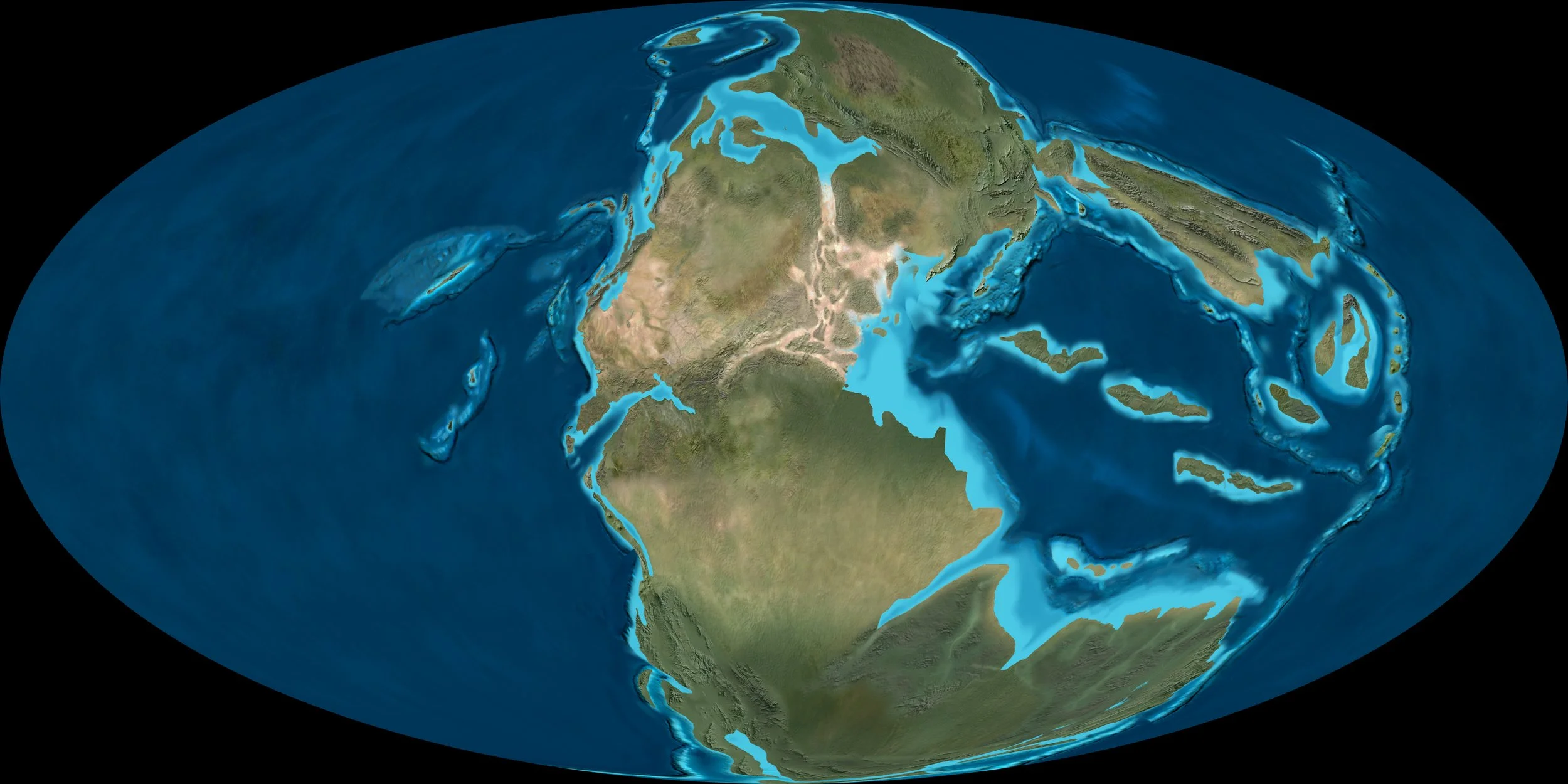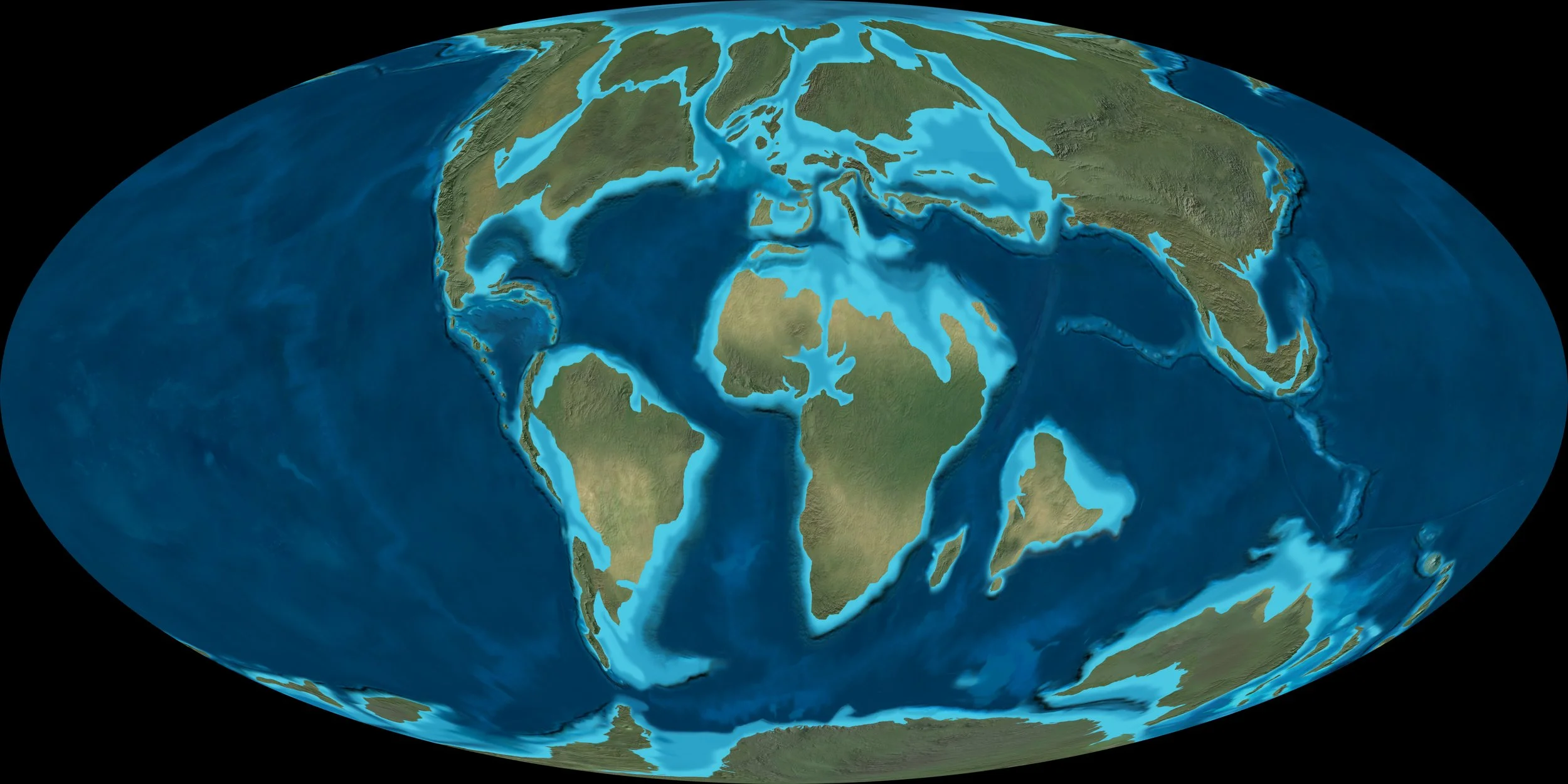An African Radiation of Duckbill Dinosaurs
The Moroccan duckbill Taleta taleta
70 million years ago, duckbill dinosaurs crossed an ocean to colonize Africa, resulting in an evolutionary radiation
Some years ago, I ran across a box of bones in Morocco. The fragments were identified as a fish, but I recognized the teeth as those of a duckbill dinosaur— tall and diamond shaped; enamel on one side and a ridge down the center. This was a shock. I’ve worked on weird fossils, like four-legged snakes. But four-legged snakes are at least predictable: snakes evolve from lizards, so if you go far enough back in time, you’ll see things that mix snake and lizard features. There’s no reason to expect a duckbill dinosaur in North Africa, and lots of good reasons to think they wouldn’t be there.
Drifting Plates, Rafting Dinosaurs
Africa splits from the northern continents around 150 million years ago, in the Jurassic. It then breaks off South America 100 million years ago, as the mid-Atlantic ridge pulls the two continents apart. Africa is now an island continent, like modern-day Australia or Madagascar.
Meanwhile, duckbills evolved 90 million years ago, in North America. Given that the continents had split up long before, and the absence of evidence for a land-bridge between Africa and the other continents, the simplest explanation for the facts was that duckbills somehow swam, drifted, or rafted on vegetation to cross the ocean, and colonized North Africa. It’s an unlikely hypothesis. But as Sherlock Holmes put it, when you eliminate the impossible, whatever remains, no matter how improbable, must be the truth.
the first known Moroccan duckbill, Ajnabia odysseus
Our duckbill was a little animal, about the size of a pony. After a bit of study, it turned out to be related to European lambeosaurines like Arenysaurus, so its ancestors probably arrived in Africa from the Iberian Peninsula. We named the animal Ajnabia odysseus. “Ajnabia” means ‘stranger’ in Arabic; the specific name of course refers to the mythical seafarer Odysseus, who spent many years wandering the Mediterranean. And it tells us that duckbills somehow crossed hundreds of miles of open water to travel from Europe to North Africa.
more dinosaur rafting…
Oceanic dispersal may be important to understanding dinosaur diversity.
We see evidence of other lineages doing the same thing- another duckbill group, the kritosaurs, dispersed over water from North America to South America. Titanosaurs went from South America to North America. Europe’s duckbills meanwhile must have swam there from Asia (Europe being an archipelago at the time). Oceanic dispersal played a much bigger role than we realized in dinosaur biogeography.
These odd biogeographic patterns are well-known, but for whatever reason people dance around the fact that these continents are separated by ocean barriers. People talk about dinosaurs moving between continents, but conveniently neglect to mention the ocean barriers.
…and some more African duckbills
braincase of Minqaria
Ajnabia was such an improbable creature, it felt like a lightning strike. I didn’t expect to see anything like Ajnabia ever again. And yet, a few years later, another partial duckbill skull turned up. Surprisingly, it wasn’t Ajnabia, but something else.
Minqaria bata, dentary, lower jaw, and braincase
This creature was named (euphonically I’d like to think, if not very creatively) Minqaria bata, Arabic for “beak” and “duck”. The braincase bones were knit and fused— despite its small size, the animal was mature.
…and a third African duckbill
upper jaw of Taleta taleta
And then last year, yet another duckbill turned up— a pair of upper jaws- which was, incredibly, unlike either Ajnabia or Minqaria. The shape of the maxilla was different, and the teeth were just bizarre- they’re huge for such a small animal, with tall, bladelike ridges on the crown, giving it a wicked grin. What’s interesting here is how different the maxillae and teeth are- the upper jaws and teeth of North American duckbills do differ in the jaws and teeth, but it tends to be more subtle variation— here we’re seeing much larger differences in jaw shape and tooth shape— which implies these things occupied a wider range of niches compared to the North American cousins.
teeth of Taleta
Curiously the number of teeth per tooth socket was reduced. Duckbills do this bizarre thing where new teeth erupt before older teeth are shed, so in one tooth position, several teeth grind food at once- imagine if you could chew with your adult teeth and your baby teeth simultaneously. But in this new animal, there’s one tooth per socket, like primitive ornithischians.
We named this animal (even less creatively) Taleta taleta- Taletha is Arabic for ‘three’, and this being the third duckbill from Couche III.
upper jaws of Ajnabia, Minqaria, and Taleta (top to bottom)
So we went from a single duckbill to three distinct species, and limb bones hint at a fourth, larger species.
I appreciate some of these differences might seem subtle if you haven’t spent a lot of time studying duckbill maxillae, but there are some really wild characters here. The low position of the jugal facet in Minqaria isn’t just unlike Ajnabia or Taleta, for example— it’s completely unlike any other lambeosaur, and looks more like a saurolophine. Likewise, the large teeth of Taleta aren’t just outliers compared to other Moroccan duckbills- no other hadrosaurid looks like this. There’s a remarkable amount of variation in these three species- maybe more variation than you get in all the North American hadrosaurids, which look pretty similar.
Duckbills not only colonized Africa, they quickly diversified afterwards, giving rise to a flock of species. Since duckbills don’t even appear in Europe until the Maastrichtian, around 72 million years ago, that leaves less than 6 million years to colonize Africa and diversify.
We see this kind of dispersal-driven radiation in islands. Islands tend to be low in diversity, so colonizing species undergo speciation as they move into vacant niches and specialize in different ways. The classic example is Galapagos finches.
After hitting the Galapagos, the ancestor of the Geospiza finches diversifies. Finches evolve to inhabit different habitats- uplands, lowlands, mangroves. They evolve different beak shapes for different foods- small beaks for insects, narrow beaks for nectar, big beaks for seeds, bigger beaks for bigger seeds. This took 2.5 million years, and produces 18 species.
A more extreme example comes from Hawaii’s honeycreeper-finches. Hawaii is a bigger, older island chain- here finch evolution had six million years to play out, in habitats from lowlands to rainforests to high mountains, and produced over 50 species, parrot-like forms, woodpecker-like forms, long-billed nectar-feeders.
the Honeycreeper-Finch radiation
Obviously duckbills aren’t finches. But the same thing happens with big herbivores. In New Zealand, we see the herbivorous moas diversify, with at least nine species, differing in size, habitat, and build, existing at the time humans showed up. Neither is this phenomenon unique to birds.
Lemurs radiated after rafting to Madagascar, evolving different builds, habits, and habitats- little nocturnal mouse-lemurs, bigger diurnal ringtail lemurs, and giant, ground-dwelling herbivorous gorilla-like lemurs (alas, now extinct).
This pattern also plays out on continental scales. A few million years ago, mice rafted on vegetation from Indonesia into New Guinea and Australia, then radiated to produce over 100 species. An older Australian radiation, the Australodelphian marsupials- kangaroos, koalas, numbats, wombats, thylacines and marsupial moles- likely results from oceanic dispersal of marsupials from South America to Australia around 55 million years ago, likely via Antarctica.
Africa’s high diversity of lambeosaurs- lots of species, different jaw shapes, different tooth shapes, possibly different body sizes- implies an adaptive radiation following dispersal, just like Galapagos finches or Australian marsupials.
The duckbill Minqaria encounters the beached remains of a Thalassotitan
Oceanic dispersal, and associated dispersal-driven radiations, aren’t just a phenomenon of islands like the Galapagos, they drive evolution of dinosaurs on continents, in Africa, South America and Europe.
The Reverse Paradigm Shift
All this is part of reverse paradigm shift. Thomas Kuhn, in his book The Structure of Scientific Revolutions, talks about the Paradigm Shift. Science doesn’t work the way everyone thinks, he says, by gathering facts and gradually changing as new facts come in. Instead, people work within existing frameworks- there are acceptable questions to ask, and acceptable theories to answer them, and acceptable methods to go about approaching the science. Eventually, however, enough new data comes in that the old theory becomes untenable. Then comes a revolution- astronomers go from putting the Earth at the center of everything, to putting the Sun in the middle, in the Copernican Revolution. Darwin’s theory of evolution, and Wegener’s theory of continental drift are also big revolutions.
But sometimes the paradigm shift goes the wrong way— sometimes the new ideas are wrong, and old theories are right. Biogeography is one example.
In the late 1800s, Darwin and Wallace wrote extensively about how species moved across oceans- floating, rafting, hitching rides on birds- and crossed land-bridges between continents. But in the mid-20th century, the discovery of continental drift seemed to make rafting unnecessary, except for remote islands like the Galapagos.
Map showing the continents united in Pangaea, 240 million years ago
If the continents were linked together millions of years ago, species could simply walk from one landmass to another. No need to invoke these improbable oceanic dispersals. It was a simple, elegant hypothesis with only one problem: it was wrong.
The big problem was that the continents broke up a very, very long time ago.
The northern continents, Laurasia, started to break away from the southern landmass of Gondwana about 200 million years ago. Then Gondwana broke up from around 160 million years ago to 100 million years ago.
Map of the Late Cretaceous, 75 Mya, when continental fragmentation and high sea levels isolated the continents
But the dinosaurs dominated the Late Cretaceous emerged after this- as did the mammals of the Cenozoic. Continental drift can’t explain why duckbills are in Africa and South America.
Neither does it explain why flightless ratite birds are found in South America (rheas), Africa (ostriches), Australia (emus and cassowaries) and New Zealand (moas)- the ratites evolved after these continents broke up, in the Paleocene. Instead, ratite ancestors could fly, and flew to various continents and independently evolved big flightless forms (curiously, ostriches evolved in Asia… then migrated to Africa once a land connection formed, and later died out in Asia) after dinosaurs went extinct. Likewise, for rodents and monkeys to travel from Africa to South America, they had to raft (and they had to raft to get to Africa from Asia in the first place).
Much of the 20th century was spent trying to force biogeography to conform to this incorrect model. It’s only in recent years that new information- better maps of the Cretaceous world, more fossils, molecular clocks to constrain the diversification of modern groups- that we’ve come to realize that the continental drift hypothesis doesn’t work for most species. The idea that continental drift could explain everything was a failed revolution. A paradigm shift, to be sure, but one that took us further from the truth.
And now slowly, study by study, fossil by fossil, we’re undoing this revolution, a re-revolution, if you like. Fossils are showing that Darwin and Wallace had it right all along. And this is ultimately what moves science forward- new data.
References
De Queiroz, A., 2005. The resurrection of oceanic dispersal in historical biogeography. Trends in Ecology & Evolution 20, 68-73.
De Queiroz, A., 2014. The monkey's voyage: how improbable journeys shaped the history of life. Basic Books (AZ).
Longrich, N.R., Pereda-Suberbiola, X., Bardet, N., Jalil, N.-E., 2024. A new small duckbilled dinosaur (Hadrosauridae: Lambeosaurinae) from Morocco and dinosaur diversity in the late Maastrichtian of North Africa. Scientific Reports 14, 3665.
Longrich, N.R., Pereda-Suberbiola, X., Bardet, N., Jalil, N.-E., 2025. A new hadrosaurid dinosaur from the late Maastrichtian Phosphates of Morocco provides evidence for an African radiation of lambeosaurines. Gondwana Research. https://doi.org/10.1016/j.gr.2025.05.006
Longrich, N.R., Pereda-Suberbiola, X., Pyron, R.A., Jalil, N.-E., 2020. The first duckbill dinosaur (Hadrosauridae: Lambeosaurinae) from Africa and the role of oceanic dispersal in dinosaur biogeography. Cretaceous Research, 104678.



